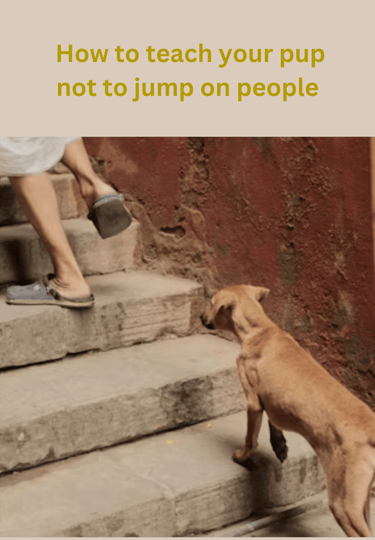Training Puppies: A Comprehensive Guide to Raising a Well-Behaved Companion
we will provide you with the most important things to know about training puppies
8/28/20255 min read


Training Puppies: A Comprehensive Guide to Raising a Well-Behaved Companion
Training a puppy is an essential part of raising a well-behaved and well-adjusted dog. Not only does it help to establish a strong bond between you and your furry friend, but it also lays the foundation for a lifetime of good behavior and obedience. However, training a puppy can be a daunting task, especially for first-time dog owners.
In this article, we will provide you with the most important things to know about training puppies, along with some valuable tips and tricks to help you get started.
Before You Start Training
Before you begin training your puppy, there are a few things to consider. First and foremost, make sure you are prepared to invest time and effort into training your puppy.
Training a puppy requires patience, consistency, and positive reinforcement. It's also essential to choose a quiet and distraction-free area for training, where your puppy can focus on you without being sidetracked.
Essential Tips for Training Your Puppy
* Try it without your dog first, so you are clear and can avoid confusing them. Before you start training your puppy, practice the commands and actions you want to teach them without your dog present. This will help you to clarify your instructions and avoid confusing your puppy
* Ensure the training is done in a calm space that is free of distractions. Choose a quiet area with minimal distractions where your puppy can focus on you. Avoid training in areas with loud noises, other pets, or people.
* Make sure your dog has eaten and been to the toilet before you start. A hungry or uncomfortable puppy will not be able to focus on training. Make sure your puppy has been fed and has had a chance to relieve themselves before starting a training session.
* Only use positive reinforcement – reward with praise or a tasty treat and mix up what you use to keep it interesting for your pooch. Positive reinforcement is a powerful training tool that encourages good behavior and builds trust between you and your puppy. Use praise, treats, and affection to reward good behavior, and mix up the rewards to keep things interesting.
* Show your pooch what you want them to do, don’t physically force them to do it. Physical force can be intimidating and even frightening for a puppy. Instead, use gentle guidance and positive reinforcement to encourage good behavior.
* Be calm and consistent. Consistency is key when training a puppy. Use a calm and clear tone of voice, and avoid getting frustrated or angry if your puppy doesn't pick up a command right away.
* Keep training sessions short (five to 10 minutes at a time) – and focus on training one behavior before ending the session with a fun game. Puppies have short attention spans, so keep training sessions short and fun. Focus on one behavior at a time, and end the session with a fun game or activity.
* Record your progress – you could film it and/or write it down. Keeping track of your progress can help you to identify areas where your puppy needs more practice or review. Consider filming your training sessions or keeping a training journal to track your puppy's progress.
* Be patient. If pup is struggling, stop and go back a step and progress more slowly next time. Training a puppy takes time and patience. If your puppy is struggling with a particular command or behavior, stop and go back a step. Progress more slowly next time, and don't be afraid to repeat a step if necessary.
* Have fun and enjoy yourself – if either of you aren’t, pick it up another day. Training a puppy should be a fun and enjoyable experience for both you and your puppy. If either of you is feeling stressed or frustrated, take a break and pick up training another day.
The Importance of Positive Reinforcement
Positive reinforcement is a powerful training tool that encourages good behavior and builds trust between you and your puppy.
By using positive reinforcement, you can encourage your puppy to exhibit good behavior, such as sitting, staying, and coming when called. Positive reinforcement can take many forms, including praise, treats, affection, and play.
Tips for Successful Puppy Training
In addition to the 10 essential tips listed above, here are a few more tips for successful puppy training:
* Be clear and consistent. Use a clear and consistent tone of voice, and avoid using complex commands or sentences.
* Use high-value rewards. Use high-value rewards, such as tasty treats and praise, to motivate your puppy and encourage good behavior.
* Practice regularly. Practice training regularly, ideally at the same time each day, to help your puppy develop a routine and reinforce good behavior.
* Socialize your puppy. Socialization is critical for puppies, as it helps them to develop good social skills and reduce the risk of anxiety and aggression.
Common Mistakes to Avoid
When training a puppy, it's essential to avoid common mistakes that can hinder the training process. Here are a few mistakes to avoid:
* Don't punish or scold your puppy. Punishment and scolding can be intimidating and even frightening for a puppy. Instead, use positive reinforcement to encourage good behavior.
* Don't over-train. Over-training can lead to frustration and burnout for both you and your puppy. Keep training sessions short and fun, and avoid pushing your puppy too hard.
* Don't expect too much too soon. Training a puppy takes time and patience. Don't expect your puppy to learn complex commands or behaviors overnight.
Conclusio
Training a puppy requires patience, consistency, and positive reinforcement. By following the 10 essential tips outlined in this article, you can set yourself and your puppy up for success.
Remember to be clear and consistent, use high-value rewards, and practice regularly. Socialization is also critical for puppies, as it helps them develop good social skills and reduces the risk of anxiety and aggression.
Avoid common mistakes, such as punishing or scolding your puppy, over-training, and expecting too much too soon. With time, effort, and patience, you can raise a well-behaved and well-adjusted dog that will be a loving companion for years to come.
Final Tips
* Stay calm and patient, even when faced with challenges.
* Make training a fun and enjoyable experience for both you and your puppy.
* Celebrate small victories and don't be too hard on yourself or your puppy when mistakes are made.
* Keep training sessions short and focused on one behavior at a time.
By following these tips and guidelines, you can help your puppy grow into a confident, well-behaved, and loving companion. Happy training!









